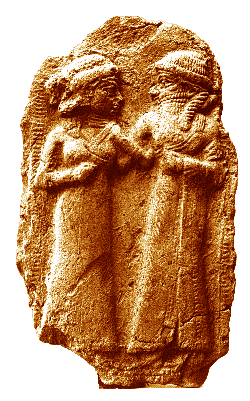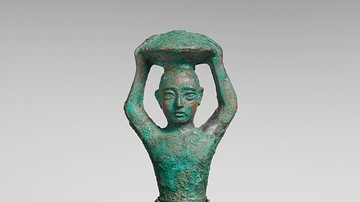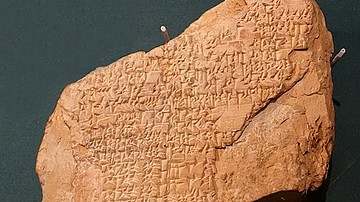The world's oldest love poem is The Love Song for Shu-Sin (c. 2000 BCE) composed in ancient Mesopotamia for use in part of the sacred rites of fertility. Prior to its discovery in the 19th century, and its translation in the 20th, the biblical Song of Songs was thought to be the oldest love poem extant.
In the 19th century, archaeologists descended on the region of Mesopotamia seeking physical evidence which would corroborate the biblical narratives of the Old Testament. While this may not have been initially their driving purpose, their need for funding (based on public interest to justify such funding) soon made it so.
Instead of finding the evidence they hoped for, they discovered cuneiform tablets which established that many of the biblical narratives were derived from Mesopotamian sources. This discovery had a profound impact not only on biblical scholarship at the time but the history of the world as it was then understood.
Excavation & Discovery
When the archaeologist Austen Henry Layard began excavations at Kalhu in 1845, assisted by Hormuzd Rassam, he was under so much pressure to find biblical sites that he jumped to the conclusion the city he had uncovered was Nineveh. His published account of the excavations, in 1849, was titled Nineveh and its Remains and, owing to Nineveh's fame from the Bible, the book became a best seller. The success of the book sparked further interest in Mesopotamian history as a means of corroborating biblical narratives and so further expeditions were sent to the region in search of other cities mentioned in the Bible.
Prior to this time, the Bible was considered the oldest book in the world and The Song of Songs from the Bible (also known as The Song of Solomon) the oldest love poem. Interestingly, the expeditions sent to historically corroborate the stories from the Bible did precisely the opposite. When Layard excavated the actual site of Nineveh in 1846-1847, he discovered the library of the Assyrian king Ashurbanipal (r. 668-627 BCE) and the cuneiform texts, which were then translated by the legendary George Smith, made it clear that the story of the Fall of Man and The Great Flood and Noah's Ark were not original compositions of the authors of the Book of Genesis but were pre-existing Mesopotamian tales which were re-worked by later Hebrew scribes. The Song of Songs, dated to the 6th-3rd centuries BCE, could no longer be considered the oldest love poem once The Love Song for Shu-Sin (written c.2000 BCE) was discovered.
Translation & Interpretation
When it was found, the cuneiform tablet of The Love Song for Shu-Sin was taken to the Istanbul Museum in Turkey where it was stored in a drawer, untranslated and unknown, until 1951 when the famous Sumerologist Samuel Noah Kramer came across it while translating ancient texts.
Kramer was trying to decide what works to translate next when he found the love song in the drawer. He describes the moment in his work History Begins at Sumer:
The little tablet numbered 2461 was lying in one of the drawers, surrounded by a number of other pieces. When I first laid eyes on it, its most attractive feature was its state of preservation. I soon realized that I was reading a poem, divided into a number of stanzas, which celebrated beauty and love, a joyous bride and a king named Shu-Sin (who ruled over the land of Sumer close to four thousand years ago). As I read it again and yet again, there was no mistaking its content. What I held in my hand was one of the oldest love songs written down by the hand of man. (245)
The poem was not just a love poem, however, but a part of the sacred rite, performed each year, known as the "sacred marriage" in which the king would symbolically marry the goddess Inanna, mate with her, and ensure fertility and prosperity for the coming year. Kramer writes:
Once a year, according to Sumerian belief, it was the sacred duty of the ruler to marry a priestess and votary of Inanna, the goddess of love and procreation, in order to ensure fertility to the soil and fecundity to the womb. The time-honored ceremony was celebrated on New Year's day and was preceeded by feasts and banquets accompanied by music, song, and dance. The poem inscribed on the little Istanbul clay tablet was in all probability recited by the chosen bride of King Shu-Sin in the course of one of these New Year celebrations. (245-246)
The scholar Jeremy Black, also well respected for his work with Mesopotamian texts, interprets the poem along the same lines. Black writes:
This is one of several love songs composed for this king which articulate a belief in his very close and personal relationship with the goddess of love. In some songs of this type, the king's name seems to have been merely substituted for that of Dumuzi [Inanna's celestial lover in myth]. Almost certainly they were performed in the context of certain religious rituals which have been referred to as the `sacred marriage' but the precise details are unknown. The belief that the king could in some sense actually have sexual intercourse with the goddess is intimately connected to the belief in the divinity of the kings of this period. (88-89)
It is likely that the king, in having sexual relations with one of Inanna's priestesses, was thought to be having sex with the goddess herself but, as Black notes, the details of the sacred marriage ritual are unknown. While the recitation of the poem by the `bride' served a religious and social function in the community by ensuring prosperity, it is also a deeply personal and affectionate composition, spoken in the female voice, concerning romantic and erotic love.
History Behind the Poem
Shu-Sin reigned as king in the city of Ur from 1973-1964 BCE according to what is known in scholarly circles as the `short chronology' but, according to the `long chronology' used by some scholars, reigned 2037-2029 BCE. The poem, therefore, is dated according to either 1965 BCE or 2030 BCE but is most often assigned a general date of composition at around 2000 BCE. Shu-Sin was the younger son of Shulgi of Ur (r. 2029-1982 BCE) who was one of the greatest kings of the Ur III Period (2047-1750 BCE). His son, Amar-Suen (r. 1982-1973 BCE), suppressed revolts and maintained the kingdom until his death by a scorpion bite, at which time Shu-Sin, considered among the best, if not the best, kings of the Ur III Period, came to the throne.
According to scholar Stephen Bertman, besides this poem, "Shu-Sin was also the male lead in a series of erotic poems in Akkadian written in dialogue form similar to the later biblical Song of Songs" (105). Long before the biblical narratives were set down, then, the Mesopotamians were writing the `first drafts' of some of the most influential works in world history.
The archaeological work done in Mesopotamia in the 19th century completely changed the way history, and the world, could be understood. Once upon a time, the ancient past stopped with the Bible and the version of history presented in the biblical narratives. Following the discovery of Mesopotamia's ancient past, history was enlarged, deepened, and humanity's story became much more complex and interesting. The literature of ancient Mesopotamia provided the first forms of world literature, the first expressions of human emotion and experience and, among them, the experience of romantic love and passion through the world's oldest love poem.
Text of the Poem
The following translation of The Love Song of Shu-Sin is from Samuel Noah Kramer's work History Begins at Sumer, pp 246-247:
Bridegroom, dear to my heart,
Goodly is your beauty, honeysweet,
Lion, dear to my heart,
Goodly is your beauty, honeysweet.You have captivated me, let me stand tremblingly before you.
Bridegroom, I would be taken by you to the bedchamber,
You have captivated me, let me stand tremblingly before you.
Lion, I would be taken by you to the bedchamber.
Bridegroom, let me caress you,
My precious caress is more savory than honey,
In the bedchamber, honey-filled,
Let me enjoy your goodly beauty,
Lion, let me caress you,
My precious caress is more savory than honey.Bridegroom, you have taken your pleasure of me,
Tell my mother, she will give you delicacies,
My father, he will give you gifts.Your spirit, I know where to cheer your spirit,
Bridegroom, sleep in our house until dawn,
Your heart, I know where to gladden your heart,
Lion, sleep in our house until dawn.You, because you love me,
Give me pray of your caresses,
My lord god, my lord protector,
My Shu-Sin, who gladdens Enlil's heart,
Give my pray of your caresses.
Your place goodly as honey, pray lay your hand on it,
Bring your hand over like a gishban-garment,
Cup your hand over it like a gishban-sikin-garmentIt is a balbale-song of Inanna.




